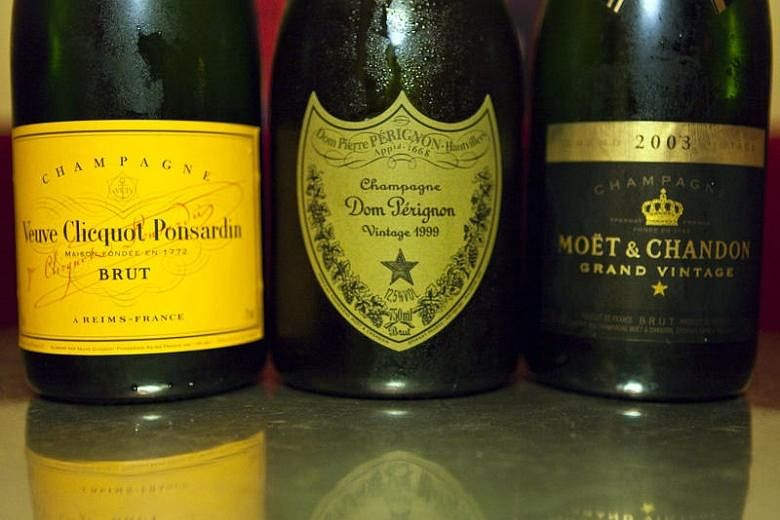(THE BUSINESS TIMES) - Another new year. What did we drink on New Year's Eve? Champagne, of course - Pol Roger Winston Churchill 2004, one of my favourite deluxe champagnes, reserved for special occasions and is too expensive to be my house champagne.
I was fortunate to be in London when Pol Roger released its first vintage, 1975, of Winston Churchill. Staying within walking distance of that great London institution Fortnum & Mason, I promptly headed there as soon as I read of its release. And to my great joy, "Yes sir, we have the Winston Churchill", greeted my ears. There is still one final bottle of the 1975 in my cellar, awaiting that special occasion (as yet unspecified) to be opened.
Sadly, the restaurant where we were drinking and ringing in the New Year did not stock Pol Roger's Winston Churchill, so we had to be content with the house champagne - which was quite decent.
Pol Roger Champagne has long been a very personal matter for me as I had the good fortune to be able to count Christian Pol Roger and his family as personal friends ever since I met Christian at the Tanglin Club on his first visit to Singapore in the mid-1980s.
As we shared a glass of his champagne, I promised to visit his winery in Epernay on my next visit to France. Of course, it was a promise kept; and was celebrated with Christian opening a bottle of his 1923 Pol Roger - a most gracious welcome and characteristic of him.
Champagne is a wine - meant to be drunk wherever and whenever we need a drink of wine, and not reserved only for special occasions.
As Madame Bollinger - of the celebrated champagne house of Bollinger - was famously reported to have said: "I drink champagne when I'm happy and when I'm sad. Sometimes I drink it when I'm alone. When I have company, I consider it obligatory. I trifle with it if I'm not hungry and drink it when I am. Otherwise, I never touch it - unless I'm thirsty."
A most apt pronouncement, and one which we could take to heart.
There is one characteristic of champagne which does tend to limit consumption - and that is its gaseous content which is kept in solution because it is under pressure in the stoppered bottle. Hence the explosive propulsion of the cork when freed from its restraint.
The higher pressure (above atmospheric) of champagne facilitates absorption of the contained alcohol into the blood, with the inevitable consequence that the brain is continuously being exposed to more alcohol which leads to accelerated intoxication. This normal physiological response deserves to be well remembered if one is driving.
Possibly the most popular champagne marque is Moet & Chandon NV (non-vintage). It is a reliable wine despite its enormous production, hence its ubiquitous reputation - and much to Moet & Chandon's credit.
One must not forget Krug, the champagne equivalent of Rolls-Royce and with a retail price to match. It is clearly not a wine for regular consumption or to be designated as one's house champagne (unless one happens to be well-heeled), but a champagne which commands and deserves great respect.
It is Krug's richness and depth which enable it to stand head and shoulders over its competitors.
So is Louis Roederer's Champagne Cristal, the champagne that one recognises immediately from the sight of its clear glass bottle - the sight of which sends many a pulse racing and palates watering in anticipation of its memorable and outstanding flavour. The story of the clear bottle is part of the magic of the wine.
Cristal was created in 1876 for the Czar of Russia at the time, Alexander II, and is regarded by many as the first prestige cuvee.
The clear bottle was specially made in response to the demand of the Czar so that he could see the bubbles and also that nothing was hidden beneath them, in particular a bomb.
The political situation in Russia at the time of his rule was unstable and the Czar feared assassination. He ordered that champagne bottles for his Three Emperors Dinner be made clear, so that he could see the bubbles. Thus came into being the clear lead glass champagne bottle with a flat bottom which so well identifies the bottle immediately as Cristal.
So much for the beginning. The finish should be just as memorable. And nothing beats port - vintage port, specifically.
Recently, I experienced a drink which stands head and shoulders above all else. It was a 100-year-old amontillado, Liquer Barbadillo - a very dark liquid with a clear rim, a full but delicate aroma of very ripe oranges and citrus fruits, its body light and a perfect balance with a tinge of caramel, blackberry fruits, coffee and a good acidity to keep the balance.
Its perfect balance and smooth mouthwatering acidity completed the portrait of an aristocrat of aristocrats. It was stunning. There is only one problem, apart from a price tag in excess of six figures: its great scarcity.

